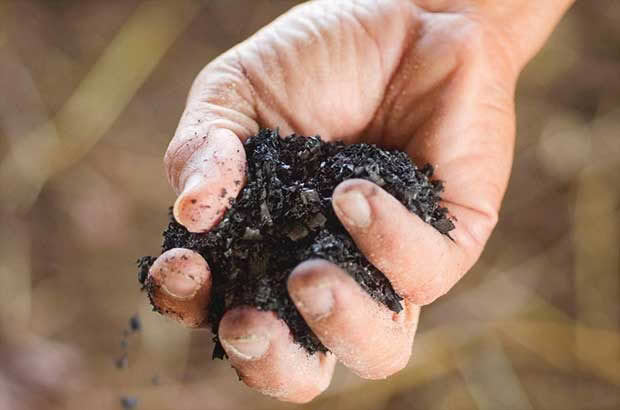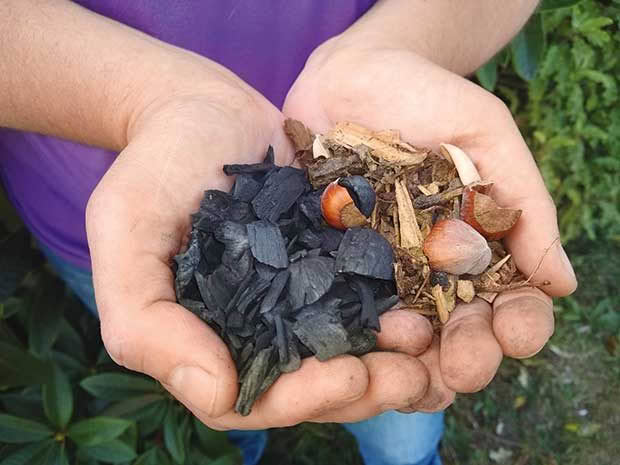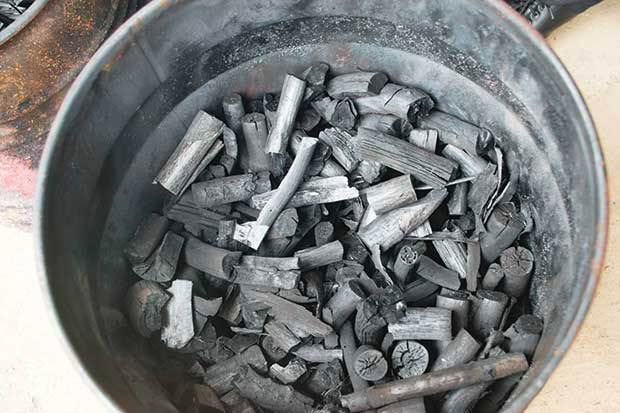4 ways to know if you’ve made good biochar

It’s easy to identify high-quality biochar.
Words: Sharon Stevens Images: Phil Stevens, Sharon Stevens
1. Feel
Biochar is surprisingly lightweight. Phil’s finished biochar weighs 25% compared to the same volume of unprocessed biomass.
2. Listen
Biochar makes a pleasant, light, high-pitched tinkling sound when you run your hands through it.
3. Smell
Good char has little or no odour. If it smells tarry or sooty, it’s not completely pyrolysed. You will need to adjust your method to burn it longer or hotter.
4. Look
Finished char is black, although some biochar will look iridescent. Smash a few larger pieces to make sure the insides are thoroughly charred.
BAD BIOCHAR
To test the quality of your biochar, take a handful of hot biochar and soak it in cold water. Poor quality biochar:
• isn’t fully charred all the way through
• will release lots of ash into the water
• has a creosote (‘old fire’) smell if you hold it close to your nose and take a deep sniff.

Another option is the ‘Hugh McLaughlin No Soap Test’. Crush some pieces of biochar between your fingers, rub the resulting ‘paste’ into your skin, then rinse it off. Good biochar will come off easily; poor quality biochar won’t and shouldn’t be used.
USING BIOCHAR TO IMPROVE YOUR SOIL
Charged biochar is an excellent addition to soil. Dig it into the top layer of garden beds or mix it with compost and topdress it over bare soil.
Phil uses it alone or in combination with potting mix to grow glasshouse plants. He broadcasts it directly onto pasture for grazing animals to work into the soil.
“We don’t measure our biochar use,” says Phil Stevens, an energy and carbon consultant with a block in Ashhurst. “We simply use what we have and then make more.”
If you have a lot of land and limited char, you might want to test what works best for plant growth in your own soils. In a range of experiments in different contexts, the International Biochar Initiative found concentrations of 500g to 5kg per square metre are most effective.
Biochar’s pH does vary depending on the ‘feedstock’ and pyrolysis method but usually has a high pH. This helps in NZ’s typically acidic soils, but be cautious if yours are alkaline. Test the biochar’s pH to check it’s right for your soil.
As biochar becomes ‘charged’ with microbial life, it will get closer to a neutral pH. If you discard the ‘quench’ water, biochar loses some of its mineral content, dropping its pH, but that’s not recommended, says Phil.
“I don’t like the idea of discarding the quench water,” he says. “That mineral content is great for fertilising soils, and adding to compost.”
CRUSH THE BIOCHAR
Some big chunks of biochar improve soil structure, increasing aeration and water movement, but smaller pieces mix better with compost and soil. Phil crushes his biochar into 1mm-5mm pieces by pounding or stomping on it with heavy boots.
Avoid breathing crushed biochar. Use a breathing mask or respirator, especially if you’re prone to asthma.

Uncharged biochar can be used as activated charcoal in animal feed, as a water filter, or as an odour eater.
Phil ‘charges’ it using several different methods. One way is to add it into animal bedding, where it absorbs nutrients from the manure.
“It keeps the bedding fresher for longer. When it’s time for clean bedding, your char will be well charged and ready for use.”
Biochar can also be charged by adding it to a compost pile or organic liquid fertiliser. Phil puts biochar in barrels of animal manure or plants such as seaweed and comfrey. Bokashi and ‘worm wee’ from vermicomposting systems also work well.
Love this story? Subscribe now!
 This article first appeared in NZ Lifestyle Block Magazine.
This article first appeared in NZ Lifestyle Block Magazine.
